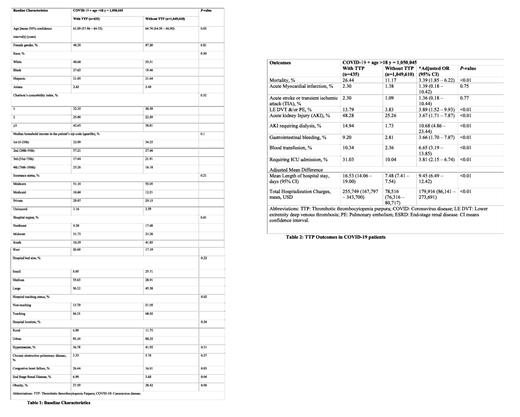Background: Thrombotic thrombocytopenic purpura (TTP) is a rare and life-threatening thrombotic microangiopathy manifesting as hemolytic anemia, thrombocytopenia, fever, neurological symptoms, and renal failure triggered by the immune response leading to reduced levels of ADAMTS-13. We conducted a retrospective study on a national scale utilizing the National Inpatient Sample (NIS) database for year 2020 assessing the influence of COVID-19-induced thrombotic thrombocytopenic purpura (TTP) on morbidity and mortality. Our research focused on adults aged 18 and above who had contracted COVID-19, with the aim of investigating the effects of TTP on mortality rates, cardiovascular complications, and healthcare expenditures within our patient population.
Results: Our study included 1,050,045 adult patients admitted with COVID-19. Of these, only 435 (0.0004%) patients developed TTP during the index hospitalization. Patients with TTP were relatively younger than those without (61.09 vs. 64.74, p = 0.03) (Table 1). Compared to patients without TTP, patients with TTP were more likely to have congestive heart failure (CHF) (26.44% vs. 16.81%, p = 0.03), ESRD (6.90% vs. 3.68%, p = 0.04), and were more often admitted to teaching hospitals (86.21% vs. 68.95%, p = 0.02) in the Midwest (51.27% vs. 23.28%, p = 0.01) and West (20.69% vs. 17.19%, p = 0.01) regions. Using multivariate regression analysis to adjust for confounders, including the severity of COVID infection (ARF, sepsis, and organ failure), we found that COVID patients with TTP had significantly higher mortality than patients without TTP (adjusted odds ratio (AOR) 3.39, 95% CI 1.85-6.22, p < 0.01) (Table 2). Additionally, COVID patients with TTP had higher odds of LE DVT/PE (AOR 3.89, 95% CI 1.52-9.93, p < 0.01), AKI (AOR 3.67, 95% CI 1.71-7.87, p < 0.01), AKI requiring dialysis (AOR 10.68, 95% CI 4.86-23.44, p < 0.01), GIB (AOR 3.66, 95% CI 1.70-7.87, p < 0.01), requiring blood transfusion (AOR 6.65, 95% CI 3.19-13.85, p < 0.01), and ICU admission (AOR 3.81, 95% CI 2.15-6.71, p < 0.01). In terms of resource utilization, patients with TTP had a longer adjusted LOS (9.45 days, 95% CI 6.49-12.42, p < 0.01) and higher adjusted total hospitalization charges ($179,916,95% CI −86,141-273,691, p < 0.01).
Conclusion: COVID-19 has been associated with TMAs, including TTP. The underlying pathophysiology includes cytokine-mediated endothelial damage and increased levels of pro-coagulant factors, such as factor VIII, vWF, and fibrinogen. Our study found that COVID-19 with concomitant TTP had a threefold higher mortality rate compared to those without TTP. Additionally, patients with TTP had a three to fourfold increased risk of LE DVT/PE, AKI, GIB, and admission to the ICU compared to patients without TTP. The presence of TTP in COVID-19 patients was also associated with longer hospital stays and higher hospitalization charges. To summarize, our study revealed that the presence of TTP in patients with COVID-19 is linked to higher mortality and an increased occurrence of complications including DVT, PE, AKI and GIB. These complications are likely the result of thrombotic events associated with TTP. Further large scale studies are warranted.
Disclosures
No relevant conflicts of interest to declare.


This feature is available to Subscribers Only
Sign In or Create an Account Close Modal